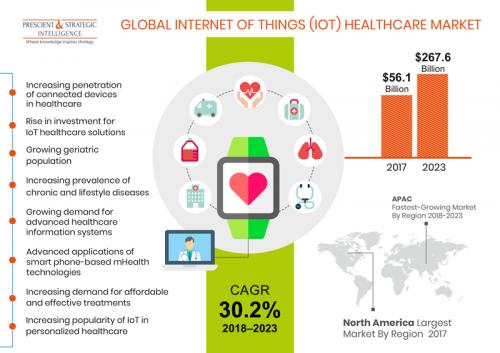Internet of Things in Healthcare Market Analysis, Share, Growth Drivers and Future Scope

One of the major technologies that has emerged in the past few years is the internet of things (IoT). This technology allows physical devices to be connected in order to exchange data with each other. Today, IoT is a part of number of industries, including the healthcare industries. By making use of IoT, the healthcare sector is bale to enhance patient outcomes and also takes away some of the pressure off healthcare professions. Due to this technology, healthcare professionals are able to provide remote healthcare facilities to patients, which allows them to focus more on patients that need more care.
Download sample copy of this report: https://www.psmarketresearch.com/market-analysis/internet-of-things-in-healthcare-market/report-sample
This further allows people to get proper medical advice without having to frequently visit the hospital. Remote patient monitoring is particularly helpful when it comes to the geriatric population, people suffering from chronic diseases, and people suffering from disability. Ascribed to these factors, the global IoT in healthcare market size is projected to generate a revenue of $267.6 billion by 2023, increasing from $56.1 billion, exhibiting a 30.2% CAGR during the forecast period (2018–2023). Services, medical devices, and systems & software are the IoT components in the healthcare industry, among which, the demand for medical devices was the highest in the past.
The different applications of IoT in healthcare are medication management, telemedicine, inpatient monitoring, clinical operations and workflow management, and connected imaging. Some other applications are connected healthcare, real time patient location services, and fitness tracking activity. Out of these, the telemedicine application was utilized the most during 2013–2017 and is further predicted to be the most in demand during the forecast period. The reason or this is the ability of this application to address an extensive range of issues which can be managed with digitization. The platform can further lower medical delivery costs and enhance the quality of care.
Browse full report at: https://www.psmarketresearch.com/market-analysis/internet-of-things-in-healthcare-market
The growing penetration of connected devices in healthcare is a key driving factor of the IoT in healthcare market. The market for connected medical devices is witnessing rapid growth due to the requirement for improving patient care, reducing treatment costs, and increasing efficiency and accountability. IoT-based medical devices can facilitate quick discharge of hospitalized patients and prevent the need for frequent hospital visits, which further decrease healthcare costs. Attributed to these factors, IoT connected devices, including oxygen tanks, insulin pumps, cardiac monitoring devices, continuous positive airway pressure machines, and defibrillators, are increasingly being adopted in remote monitoring. These devices provide patients and their caregivers important information and eliminate the need for frequently visiting healthcare facilities.
Advertise on APSense
This advertising space is available.
Post Your Ad Here
Post Your Ad Here
Comments